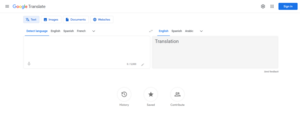
Back Google Translate Afrikaans Google Translate ANG ترجمة جوجل Arabic ترجمة جوجل ARZ গুগল ট্ৰান্সলেট Assamese Google Translate AST Google Translate Aymara Google Translate Azerbaijani Google Translate BAN Google Translate BCL
 | |
 Google Translate website homepage | |
Type of site | Neural machine translation |
|---|---|
| Available in | 249 languages; see below |
| Owner | |
| URL | translate |
| Commercial | Yes |
| Registration | Optional |
| Users | Over 500 million people daily |
| Launched | April 28, 2006 (as statistical machine translation)[1] November 15, 2016 (as neural machine translation)[2] |
| Current status | Active |
Google Translate is a multilingual neural machine translation service developed by Google to translate text, documents and websites from one language into another. It offers a website interface, a mobile app for Android and iOS, as well as an API that helps developers build browser extensions and software applications.[3] As of January 2025, Google Translate supports 249 languages and language varieties at various levels.[4][5] It served over 200 million people daily in May 2013,[6] and over 500 million total users as of April 2016[update],[7] with more than 100 billion words translated daily.
Launched in April 2006 as a statistical machine translation service, it originally used United Nations and European Parliament documents and transcripts to gather linguistic data. Rather than translating languages directly, it first translated text to English and then pivoted to the target language in most of the language combinations it posited in its grid,[8] with a few exceptions including Catalan–Spanish.[9] During a translation, it looked for patterns in millions of documents to help decide which words to choose and how to arrange them in the target language. In recent years, it has used a deep learning model to power its translations. Its accuracy, which has been criticized[by whom?] on several occasions,[10] has been measured to vary greatly across languages.[11] In November 2016, Google announced that Google Translate would switch to a neural machine translation engine – Google Neural Machine Translation (GNMT) – which translated "whole sentences at a time, rather than just piece by piece. It uses this broader context to help it figure out the most relevant translation, which it then rearranges and adjusts to be more like a human speaking with proper grammar".[2]
- ^ Och, Franz Josef (April 28, 2006). "Statistical machine translation live". Google AI Blog. Google Inc. Archived from the original on May 23, 2018. Retrieved February 15, 2011.
- ^ a b Turovsky, Barak (November 15, 2016). "Found in translation: More accurate, fluent sentences in Google Translate". The Keyword Google Blog. Google Inc. Archived from the original on April 7, 2017. Retrieved December 1, 2016.
- ^ "Translations Made Simple: The Usefulness of Translation Apps". Ulatus. April 8, 2020. Archived from the original on April 29, 2020. Retrieved April 29, 2020.
- ^ "See which features work with each language". Google Translate. Google Inc. Archived from the original on January 12, 2021. Retrieved July 13, 2015.
- ^ Caswell, Isaac (June 27, 2024). "110 new languages are coming to Google Translate". Google Translate Blog. Google Inc. Retrieved June 30, 2024.
- ^ Shankland, Stephen (May 18, 2013). "Google Translate now serves 200 million people daily". CNET. Red Ventures; CBS Interactive (at the time of publication). Archived from the original on December 4, 2019. Retrieved October 17, 2014.
- ^ Turovsky, Barak (April 28, 2016). "Ten years of Google Translate". Google Translate Blog. Google Inc. Archived from the original on December 24, 2019. Retrieved December 24, 2019.
- ^ Benjamin, Martin (April 1, 2019). "How GT Pivots through English". Teach You Backwards. Archived from the original on January 13, 2021. Retrieved December 24, 2019.
- ^ Benjamin, Martin (April 1, 2019). "Catalan to Spanish Translations". Teach You Backwards. Archived from the original on December 24, 2019. Retrieved December 24, 2019.
- ^ Hofstadter, Douglas (January 30, 2018). "The Shallowness of Google Translate". The Atlantic. Archived from the original on March 22, 2020. Retrieved March 24, 2020.
- ^ Benjamin, Martin (March 30, 2019). "Source data for Teach You Backwards: An In-Depth Study of Google Translate for 108 Languages". Teach You Backwards. Archived from the original on December 24, 2019. Retrieved December 24, 2019.